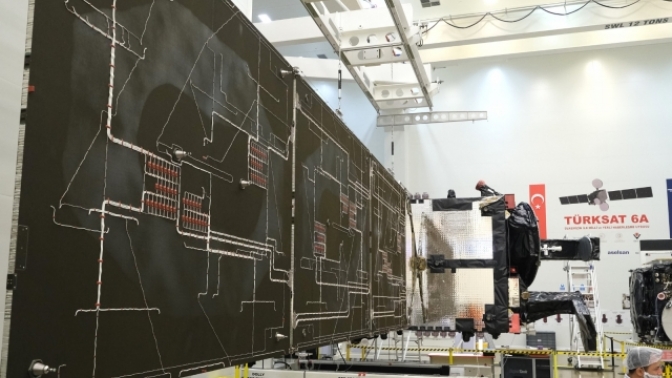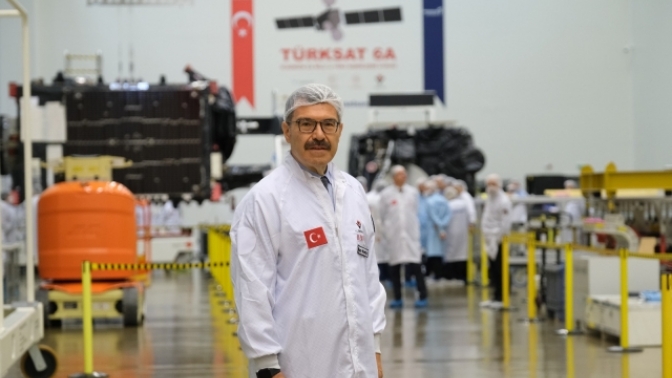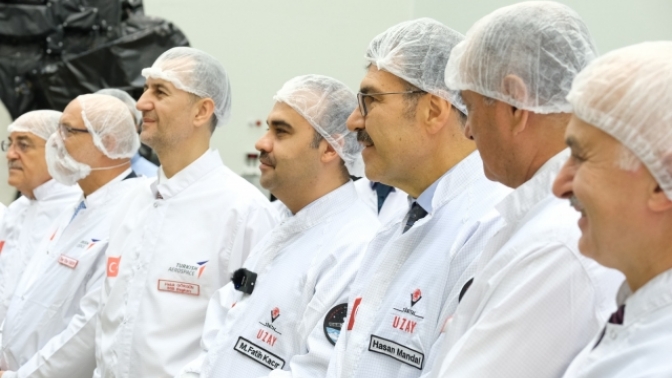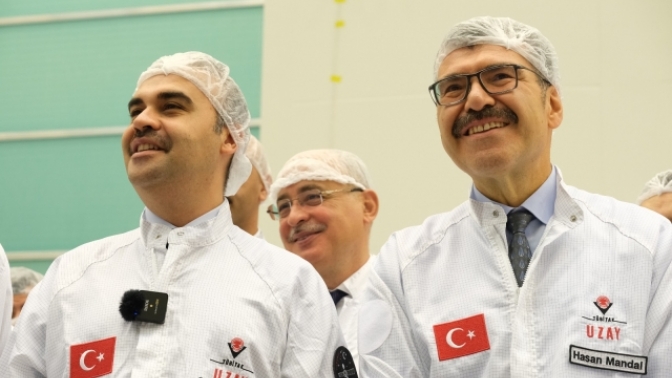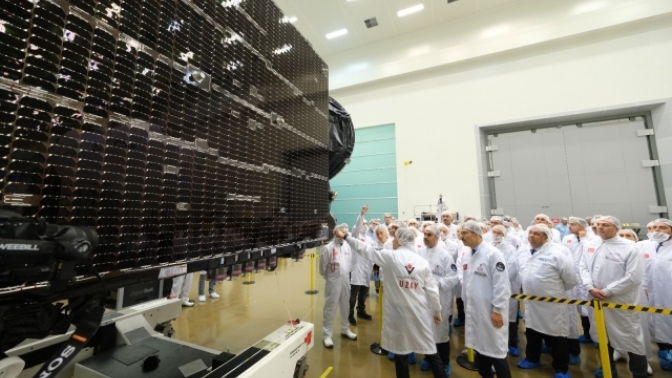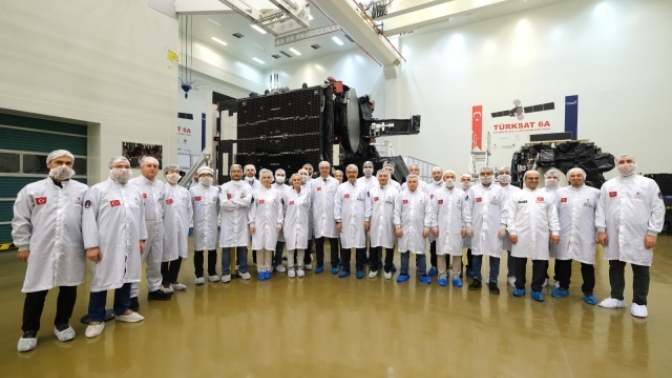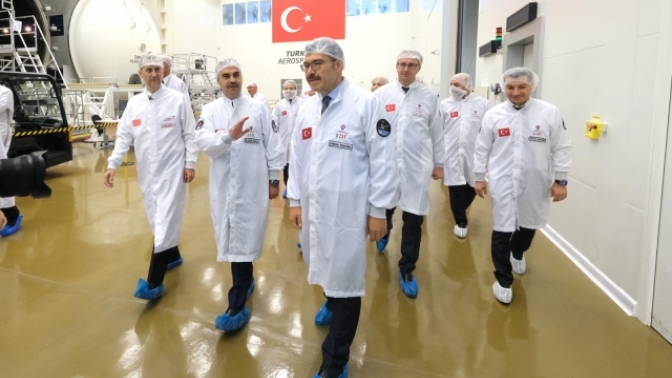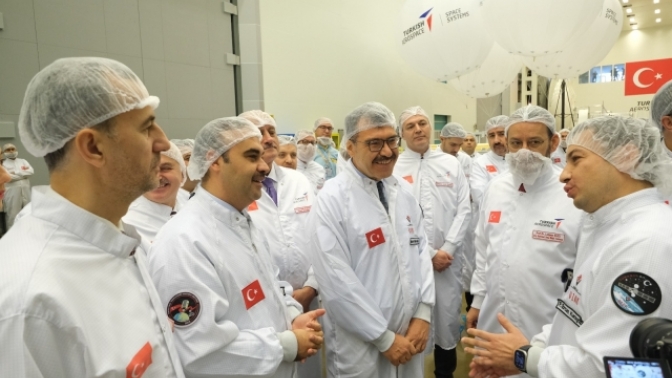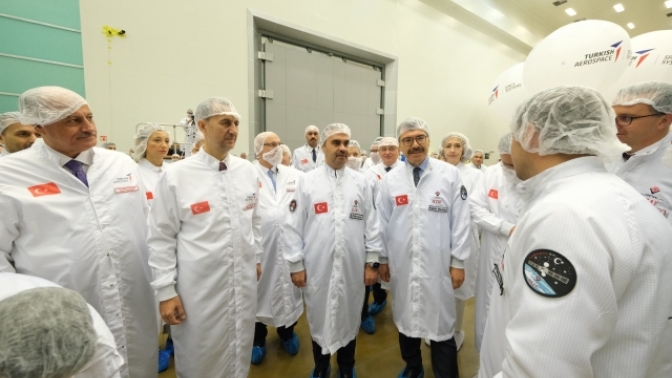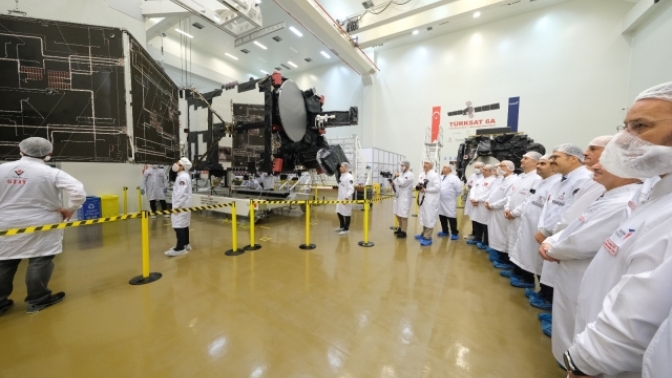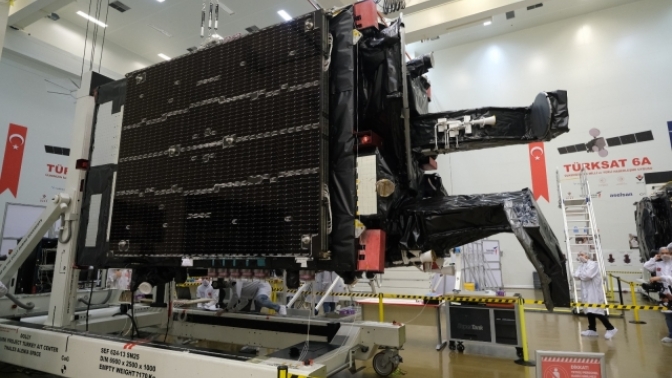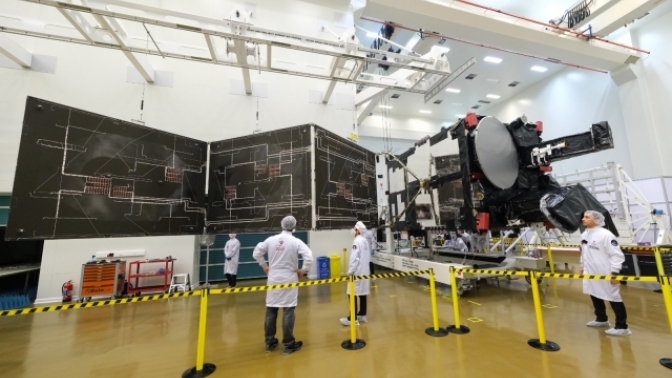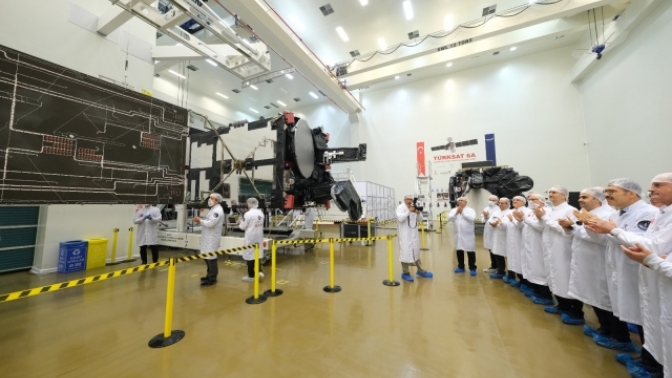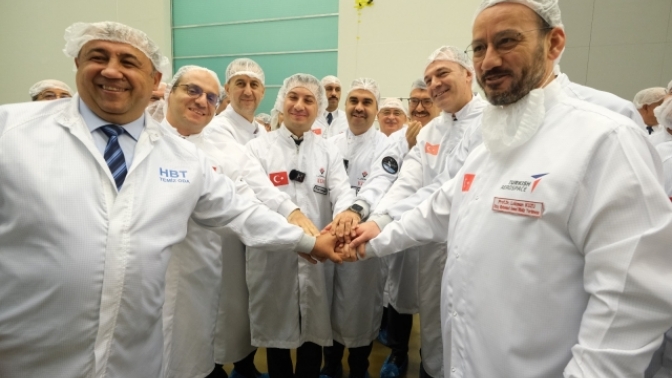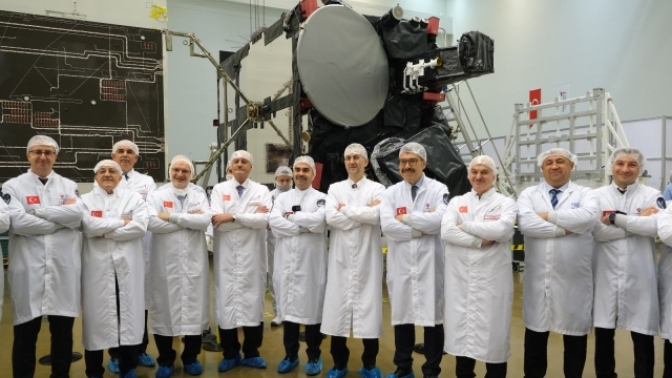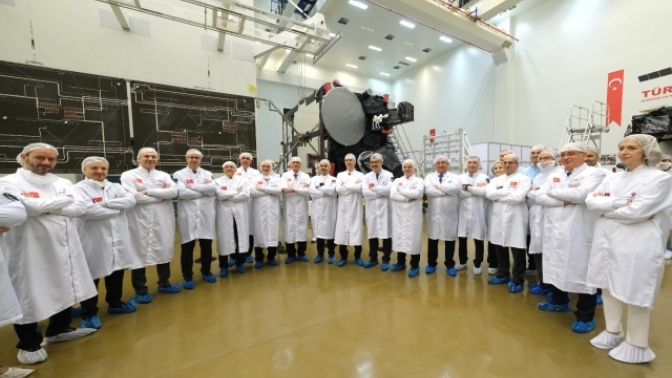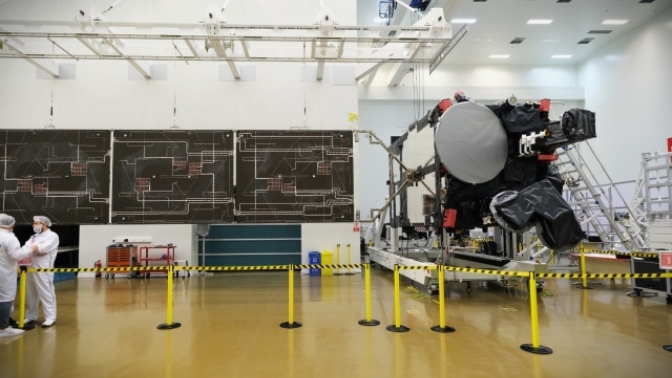The deployment tests of the high-power capacity solar panels of TÜRKSAT 6A, Türkiye's first domestic and national communication satellite that is developed under the coordination of TÜBİTAK UZAY, have been successfully completed. After this stage, launcher compatibility tests, final functional tests and payload performance tests will be carried out respectively, and then the satellite will be ready for transportation to the launch site.
Speaking at the TÜRKSAT 6A solar panel deployment test held at the Space Systems Integration and Test (USET) Centre at TAI, Minister of Industry and Technology Mehmet Fatih Kacır said, “We will send TÜRKSAT 6A into space next year. Thus, Türkiye will be one of the 10 countries that can develop, produce and use its own communication satellites in space with its domestic and national capabilities.”
Pointing out that TÜRKSAT 6A is one of the important projects of the National Space Program carried out under the leadership of President Recep Tayyip Erdoğan within the scope of the National Technology Move, Kacır said, “We will send it to space next year. Thus, Türkiye will be one of the 10 countries that can develop, produce and use its own communication satellites in space with its domestic and national resources. Of course, TÜRKSAT operates in the field of communication satellites, and TÜRKSAT 6A will especially provide the opportunity for TÜRKSAT to provide services to a geography covering more than 1.5 billion people.”
It contains much more advanced technologies.
Stating that TÜRKSAT 6A contains much more advanced technologies compared to Türkiye's previous experiences, Minister Kacır said, “Türkiye has gained great experience in imaging satellites in 20 years. Our journey, which started with BILSAT joint production efforts, has reached sub-meter resolution satellites in imaging satellites with RASAT, Göktürk and most recently İMECE. provided access. We sent İMECE into space in April, and we are already utilizing İMECE effectively. Now we are taking a step towards communication satellites with TÜRKSAT 6A. "Our hope is that with this experience we will gain, Türkiye will be able to get a much larger share of the space economy, which is approaching 600 billion dollars, in the coming period, and at the same time, we will be able to continue our development processes with our local and national capabilities in many applications that are of strategic importance for our national security."
A tremendous collaboration project
Kacır noted that TÜBİTAK UZAY, TUSAŞ, ASELSAN, C-Tech and many stakeholders played an important role in the project and said, “Actually, it is a tremendous cooperation project. The centre we are located in is a centre operating on the TAI campus built by our Presidency of Defence Industries, and thanks to this centre, we carry out all our satellite development processes and space systems with our own infrastructures, human capital and human resources, with local and national means. We have the opportunity to realize it with our skills.”
We Go Above 30 Thousand Kilometres
Stating that the Lunar Research Project in the National Space Program will take Türkiye to deep space, Kacır said, “We were under a thousand kilometres in İMECE, now we are going over 30 thousand kilometres with TÜRKSAT 6A, but when we reach to the moon, we will have completed a 380-thousand-kilometre journey in space. In all these projects, domestic and national development of subsystems, core components and technologies will always continue to be our primary goal.”
Our aim is “To be an advanced country in space technologies”
Minister Kacır said, “TÜRKSAT 6A will be completed in 2024, and then our project within the scope of the Lunar Research Program will be completed at the end of 2025 and the beginning of 2026. On the other hand, we will continue to develop new projects in the National Space Program, especially on low orbit constellations. Türkiye benefits from space technologies at the most advanced level and has all these technological "We will continue our work rapidly in line with the goal set by our President in order to become a country that can develop its capabilities with local and national means."
SSB President Haluk Görgün: “All kinds of environments to which the satellites will be exposed are being simulated.”
President of the Presidency of Defense Industries Prof. Dr. Haluk Görgün said, “The facility we are in; It is one of the facilities in 6 countries. Here, not only the integration of the satellites to be sent into space is carried out, but also all kinds of environments to which the satellites will be exposed are simulated and tests are carried out to ensure that they fulfil their functions. "Today, we did the deployment test of the solar panels, and thermal tests and vacuum tests are also carried out in this facility."
President of TÜBİTAK Hasan Mandal: “We will be one of the few countries with a communication satellite.”
President of the Scientific and Technological Research Council of Türkiye (TÜBİTAK) Prof. Dr. Hasan Mandal also launched a rare communication satellite with TÜRKSAT 6A, which will be launched in 2024. He stated that we will be one of the countries. "If we are talking about smart machines, systems, and the fifth industrial revolution, communication and communications satellites are very valuable," Mandal, reminding that the first domestic and national observation satellite, İMECE, was sent into space on April 15.
Stating that they can receive high resolution images from anywhere on the world without relying on any external authority, Mandal continued as follows: "We designed, developed and produced the components ourselves. We even export some of the components abroad. We will launch the first domestic communication satellite, TÜRKSAT 6A, in 2024." We will be one of the few countries with a communication satellite. If we are talking about smart machines, systems and the fifth industrial revolution, communication and communications satellites are very valuable. The national technology move means complete independence. To achieve full independence, you will also be independent in space. 'Türkiye Century, fully independent Türkiye' If we are talking about the good, we need to be independent in every field. Why do we need 'UAVs' and air defence systems? there is need?' they said. Here is what is happening in the world. We have missiles and UAVs, but their control and positioning is in space. Now we ask 'Why is space needed? Is everything over and now it's space's turn?' they say. It is in space that all our defence systems are controlled. If you do not have control over space, if you do not have satellites, you need to receive communication from a satellite on someone else for all the technologies you have developed. "If that country does not allow you to use its satellite or take photos and videos, you mean 'no'."
Applause to those who contributed
Minister Kacır and his entourage received information from the engineers working on the TÜRKSAT 6A satellite. Minister Kacır said, “The heroes of this project are "Scientists, engineers and technicians who work day and night and put in mental effort within the scope of this project." He applauded those who contributed to the TÜRKSAT 6A satellite works.
The program was attended by President of the Presidency of Defence Industries, Prof. Dr. Haluk Görgün, Deputy Minister of Industry and Technology Zekeriya Çoştu, Deputy Minister of National Defense Şuay Alpay, TÜBİTAK President Prof. Dr. Hasan Mandal, Turkish Space Agency President Yusuf Kıraç, TAI Chairman of the Board of Directors Prof. Dr. Rafet Bozdoğan, TAI Deputy Chairman of the Board of Directors Ömer Cihad Vardan and TAI General Manager Prof. Dr. Temel Kotil also participated.
Coordination of TÜRKSAT 6A is in TÜBİTAK UZAY
Ministry of Transport and Infrastructure, TÜRKSAT A.Ş. and TÜBİTAK UZAY in the TÜRKSAT 6A project financed by TÜBİTAK; It is developing the national communication satellite together with its project partners TAI, ASELSAN and CTech companies. In the project, firstly system level test models were produced, finally the integration work of the flight model that will operate in orbit was completed and final tests are carried out before transportation to the launch site.
The assembly, integration, and testing activities of the TÜRKSAT 6A satellite are carried out at the Space Systems Integration and Test (USET) Center at TAI. It will be placed in geosynchronous orbit at 42° east. The satellite that weighs over 4 tonnes will be operated by TÜRKSAT.
The TÜRKSAT 6A satellite carries 16 Ku-Band transponders through which it brings significant capacity increase, technological competence, and other critical advantages to our country in the field of secure data communication.


